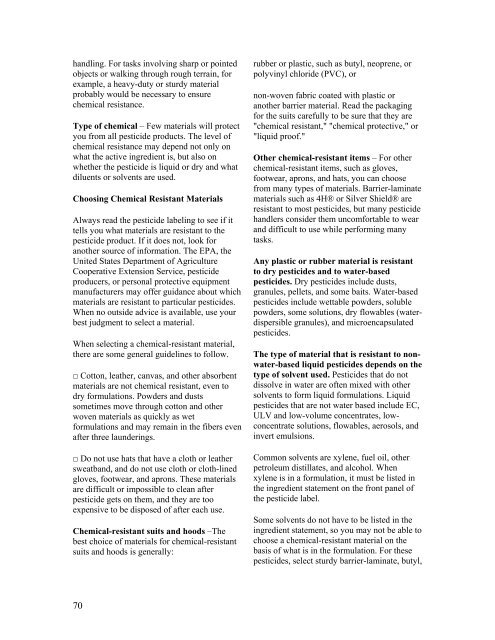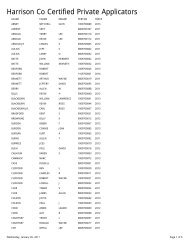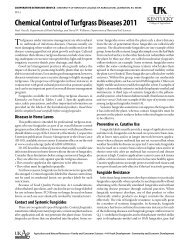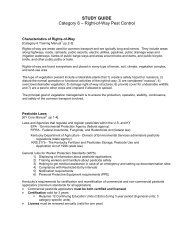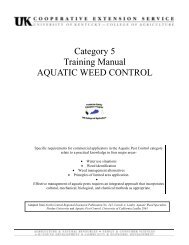Applying Pesticides Correctly - University of Kentucky
Applying Pesticides Correctly - University of Kentucky
Applying Pesticides Correctly - University of Kentucky
You also want an ePaper? Increase the reach of your titles
YUMPU automatically turns print PDFs into web optimized ePapers that Google loves.
handling. For tasks involving sharp or pointed<br />
objects or walking through rough terrain, for<br />
example, a heavy-duty or sturdy material<br />
probably would be necessary to ensure<br />
chemical resistance.<br />
Type <strong>of</strong> chemical – Few materials will protect<br />
you from all pesticide products. The level <strong>of</strong><br />
chemical resistance may depend not only on<br />
what the active ingredient is, but also on<br />
whether the pesticide is liquid or dry and what<br />
diluents or solvents are used.<br />
Choosing Chemical Resistant Materials<br />
Always read the pesticide labeling to see if it<br />
tells you what materials are resistant to the<br />
pesticide product. If it does not, look for<br />
another source <strong>of</strong> information. The EPA, the<br />
United States Department <strong>of</strong> Agriculture<br />
Cooperative Extension Service, pesticide<br />
producers, or personal protective equipment<br />
manufacturers may <strong>of</strong>fer guidance about which<br />
materials are resistant to particular pesticides.<br />
When no outside advice is available, use your<br />
best judgment to select a material.<br />
When selecting a chemical-resistant material,<br />
there are some general guidelines to follow.<br />
□ Cotton, leather, canvas, and other absorbent<br />
materials are not chemical resistant, even to<br />
dry formulations. Powders and dusts<br />
sometimes move through cotton and other<br />
woven materials as quickly as wet<br />
formulations and may remain in the fibers even<br />
after three launderings.<br />
□ Do not use hats that have a cloth or leather<br />
sweatband, and do not use cloth or cloth-lined<br />
gloves, footwear, and aprons. These materials<br />
are difficult or impossible to clean after<br />
pesticide gets on them, and they are too<br />
expensive to be disposed <strong>of</strong> after each use.<br />
Chemical-resistant suits and hoods –The<br />
best choice <strong>of</strong> materials for chemical-resistant<br />
suits and hoods is generally:<br />
rubber or plastic, such as butyl, neoprene, or<br />
polyvinyl chloride (PVC), or<br />
non-woven fabric coated with plastic or<br />
another barrier material. Read the packaging<br />
for the suits carefully to be sure that they are<br />
"chemical resistant," "chemical protective," or<br />
"liquid pro<strong>of</strong>."<br />
Other chemical-resistant items – For other<br />
chemical-resistant items, such as gloves,<br />
footwear, aprons, and hats, you can choose<br />
from many types <strong>of</strong> materials. Barrier-laminate<br />
materials such as 4H® or Silver Shield® are<br />
resistant to most pesticides, but many pesticide<br />
handlers consider them uncomfortable to wear<br />
and difficult to use while performing many<br />
tasks.<br />
Any plastic or rubber material is resistant<br />
to dry pesticides and to water-based<br />
pesticides. Dry pesticides include dusts,<br />
granules, pellets, and some baits. Water-based<br />
pesticides include wettable powders, soluble<br />
powders, some solutions, dry flowables (waterdispersible<br />
granules), and microencapsulated<br />
pesticides.<br />
The type <strong>of</strong> material that is resistant to nonwater-based<br />
liquid pesticides depends on the<br />
type <strong>of</strong> solvent used. <strong>Pesticides</strong> that do not<br />
dissolve in water are <strong>of</strong>ten mixed with other<br />
solvents to form liquid formulations. Liquid<br />
pesticides that are not water based include EC,<br />
ULV and low-volume concentrates, lowconcentrate<br />
solutions, flowables, aerosols, and<br />
invert emulsions.<br />
Common solvents are xylene, fuel oil, other<br />
petroleum distillates, and alcohol. When<br />
xylene is in a formulation, it must be listed in<br />
the ingredient statement on the front panel <strong>of</strong><br />
the pesticide label.<br />
Some solvents do not have to be listed in the<br />
ingredient statement, so you may not be able to<br />
choose a chemical-resistant material on the<br />
basis <strong>of</strong> what is in the formulation. For these<br />
pesticides, select sturdy barrier-laminate, butyl,<br />
70


